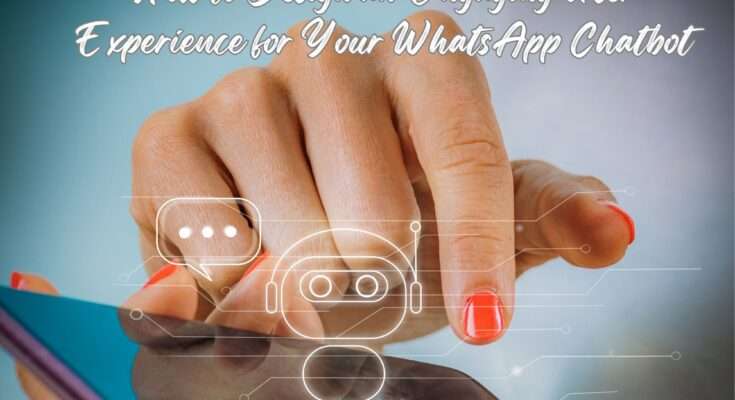WhatsApp chatbots are becoming increasingly popular for businesses as a means to interact with their customers. But how do you go about designing an engaging user experience for your WhatsApp chatbot? In this blog post, we will delve into the purpose of a WhatsApp chatbot, provide guidance on crafting an engaging user experience, and offer tips for creating an effective WhatsApp chatbot.
The Purpose of a WhatsApp Chatbot

WhatsApp chatbots are all the rage these days, and for good reason. Chatbots provide an easy and efficient way to interact with your customers quickly and effectively. But how can you design a WhatsApp chatbot that provides an engaging user experience?
Also read: The Benefits of Using an Automatic Watch Winder
The first step is to understand the objectives and goals of your chatbot. This will help you determine what type of user journey you should create, as well as the purpose of your chatbot. Once this is established, it’s time to start designing messages that will trigger responses from users. It’s important to incorporate conversational elements into your chatbot’s responses, such as natural language processing (NLP) technology for personalized replies or automated decision-making capabilities for complex conversations. Additionally, providing feedback loops can help collect data on each interaction so that you can better understand how users are interacting with your chatbot.
When designing a WhatsApp chatbot, it is also essential to create an engaging conversation flow that encourages users to continue the dialogue. Aim for a delightful experience by ensuring that the interface is easy to use and navigate while allowing customers to complete tasks quickly and accurately.
By following these tips, you can design an engaging user experience for your WhatsApp Chatbot that will revolutionize customer engagement!
Essential Design Principles of a User Friendly Chatbot
Chatbots are increasingly popular for businesses and organizations aiming to provide an engaging and personalized user experience. WhatsApp chatbots offer unique interaction options for customers, with a range of features and functionalities. To design a user-friendly WhatsApp chatbot, it is essential to comprehend its purpose and implement necessary design principles.
When designing your WhatsApp chatbot, the first step is understanding the user’s intent from the beginning of their conversation. This helps in tailoring the bot’s dialogue effectively to address their needs. Use conversational language and provide simple onboarding for users to know how to interact best with the bot. Adjust conversations based on user input, ensuring accurate and detailed responses to specific questions.
The bot should be responsive to avoid long wait times and keep users engaged. Offer relevant information based on conversations, including tailored offers or discounts based on previous interactions, or general product information specific to each user. Leveraging AI, such as natural language processing (NLP), helps to understand user queries better and provide accurate answers.
Regularly test the bot to identify and fix bugs before going live. Provide clear introductions to guide users on interaction and set expectations for the results they can expect. Maintain a friendly tone throughout conversations for a more successful engagement between customers and bots. Collect user feedback regularly to improve future interactions.
Designing an Engaging User Experience for WhatsApp Chatbot
WhatsApp chatbot technology is revolutionizing the way businesses communicate with customers. It is an easy and cost-effective way to reach a large number of people with personalized, automated conversations. However, in order to be successful, it is important to design an engaging user experience.
First, understand the characteristics of a successful customer experience: clarity, ease of use, purposeful interactions, consistency across platforms and devices, meaningful feedback from users, and clear prompts. Next, determine what type of interaction is best for your chatbot – text-based or voice-based. Developing a plan is essential for creating an engaging user experience. This includes understanding your target user and planning out the conversation flow between the bot and users.
Choose a conversational framework that will provide structure for your chatbot’s conversations. Also, include creative design elements such as emojis or GIFs that make interactions more fun.
Once you have designed your chatbot’s user interface (UI), you can begin testing it on different platforms and devices to ensure compatibility across all channels. Utilize analytics insights to measure success rates, such as clicks per message sent, and use these insights to optimize user experiences accordingly. Finally, gather feedback from users through surveys on how they are interacting with your bot, so you can make improvements accordingly if needed.
Tips for Creating an Effective WhatsApp Chatbot

WhatsApp chatbots are rapidly becoming a powerful tool in the digital marketing arsenal, enabling businesses to engage with their customers in an interactive and automated manner. As the technology evolves, it is crucial for businesses to understand how to design and implement a WhatsApp chatbot effectively to maximize its impact. Here are some tips for creating an effective WhatsApp Chatbot:
First and foremost, conduct research on your target audience and gain insights into their preferences and needs. Once you have identified the purpose, you can begin designing the user experience (UX).
This allows users to type out their queries rather than navigating through menus or buttons, which can be tedious. Include a simple onboarding process for new users to quickly familiarize themselves with your bot.
Leverage customer feedback loops throughout the UX design process to continually improve the bot’s performance. Focus on ensuring that customers have a positive experience by avoiding complex conversational paths and using buttons where possible. This prevents customers from getting lost or confused while navigating through conversations. This ensures that customers have all the necessary information before engaging, leading to improved overall customer satisfaction.
Finally, provide value through personalized content recommendations or helpful advice tailored to each user’s preferences. This helps increase engagement levels among both current and potential customers. Constantly test and optimize the chatbot by measuring key metrics such as response times and analyzing user feedback regularly. This allows for necessary changes and tweaks to enhance the overall user experience (UX).
In a Nutshell
Designing an engaging user experience for your WhatsApp chatbot is essential to ensuring positive customer engagement. By understanding the purpose of the chatbot, crafting a user-friendly conversation flow, and leveraging AI technologies such as natural language processing (NLP), businesses can create a successful WhatsApp chatbot that provides an enjoyable user experience. Additionally, testing and feedback loops are integral parts of creating an effective WhatsApp chatbot, so make sure to include them in your design process. Now is the time to start designing an engaging user experience for your WhatsApp chatbot – take action today!




I m amanat place halp me it’s very poor man